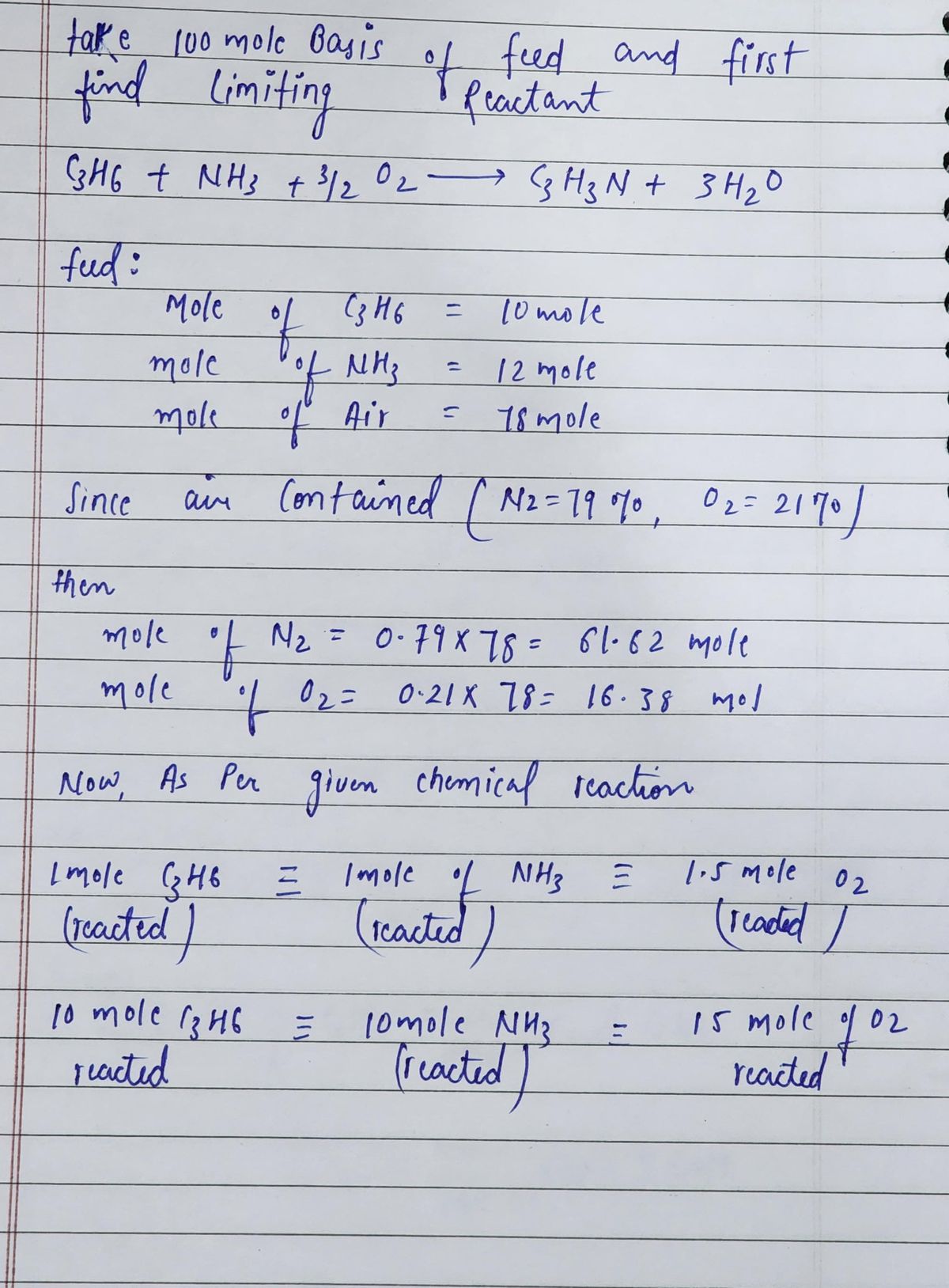C3H6 + N¥²/₂ + 2/20₁₂ → Cz Hz № + 3H₂2 0 e The feed to propylene anmoxidation of grocess contain's 10.0 mole to propylene 1200 ammonia, and 78.0% air. A fractional Conversion of 30.0% of the limiting reactant 15 achieved. Taking 100 mul of feed to as a bans determine which reactaint 15 limiting and the molar amounts of all gar constituents for a 305 conversion of the limiting reactant. determine the molar amounts in atomic species balancer and millecalor specier balancen Goswers reactor Ladan 6100 Mal₂4/0/1/ GILUMYND₂/out Sonsumarno I 02/06) 0₂/nair 6,79 mul N₂/mol air [ MegHG (nu) (H₂) PNH3 (mu) N₁13) มหา hot (mot Oc) naz (MoN₂) MC₂513 N (MS) (₂H₂N) Muss (Mol the) answers Desto ² 7.0 mu) (₂) 1 x niny 2 9. U mul MM3 no₂² 11,9 molo₂ 61.6 mt NE AM² neznaN = 3,00 m GM₂N MNE (1.6 m) №₂ n₂02 9. Umul 1₂0 て
C3H6 + N¥²/₂ + 2/20₁₂ → Cz Hz № + 3H₂2 0 e The feed to propylene anmoxidation of grocess contain's 10.0 mole to propylene 1200 ammonia, and 78.0% air. A fractional Conversion of 30.0% of the limiting reactant 15 achieved. Taking 100 mul of feed to as a bans determine which reactaint 15 limiting and the molar amounts of all gar constituents for a 305 conversion of the limiting reactant. determine the molar amounts in atomic species balancer and millecalor specier balancen Goswers reactor Ladan 6100 Mal₂4/0/1/ GILUMYND₂/out Sonsumarno I 02/06) 0₂/nair 6,79 mul N₂/mol air [ MegHG (nu) (H₂) PNH3 (mu) N₁13) มหา hot (mot Oc) naz (MoN₂) MC₂513 N (MS) (₂H₂N) Muss (Mol the) answers Desto ² 7.0 mu) (₂) 1 x niny 2 9. U mul MM3 no₂² 11,9 molo₂ 61.6 mt NE AM² neznaN = 3,00 m GM₂N MNE (1.6 m) №₂ n₂02 9. Umul 1₂0 て
Introduction to Chemical Engineering Thermodynamics
8th Edition
ISBN:9781259696527
Author:J.M. Smith Termodinamica en ingenieria quimica, Hendrick C Van Ness, Michael Abbott, Mark Swihart
Publisher:J.M. Smith Termodinamica en ingenieria quimica, Hendrick C Van Ness, Michael Abbott, Mark Swihart
Chapter1: Introduction
Section: Chapter Questions
Problem 1.1P
Related questions
Question
chemical processes: reactive processes. Determine the molar amounts using the methods of atomic species balances and molecular species balances. Do not use the extent of reaction.

Transcribed Image Text:C3H6 + NH₂ + 2₂20₂ C3 H z Ne 37/₂
NH302
The feed to propylene anmoxidation of
process contain's 10.0 mole to propylene
ammonia, 78.0%
fractional
Conversion of 30.0% of the limiting reactant
15 achieved. Taking 100 mul of feed was a
bans determine which reactant 15 limiting
and the molar amounts of all gar comotituents
for a 30% conversion of the limiting reactant.
determine the molar, amounts in
atomic species balancer and
molecular specier balancen
Gooswers
reactor
100 AN
6.100 ml ₂4/0/ANT
GIL MY NA ₂/out
Sonsumargra I
6210) 0₂/01 air
6,79 mol N₂l molair
[
Mesto (ns) (16)
PWMS (Mu) N₁13)
(mul
ANYS
hot (md Oc)
MAL (MUN₂)
MC₂513 N (M³) (3H₂N)
Mund (Mal the)
answers, Dato ² 7.0 mu) (₂) 1 x
ning ² q. U mul MM3
no₂² 11 9 mol O₂
AN 61.6 mot NE
neznaN = 3,00 m√ GM₂N
MNE Col₂ 6mul N₂
2
10² 9. J mul Med
Expert Solution
Step 1: Step 1 of 4

Step by step
Solved in 5 steps with 3 images

Recommended textbooks for you

Introduction to Chemical Engineering Thermodynami…
Chemical Engineering
ISBN:
9781259696527
Author:
J.M. Smith Termodinamica en ingenieria quimica, Hendrick C Van Ness, Michael Abbott, Mark Swihart
Publisher:
McGraw-Hill Education

Elementary Principles of Chemical Processes, Bind…
Chemical Engineering
ISBN:
9781118431221
Author:
Richard M. Felder, Ronald W. Rousseau, Lisa G. Bullard
Publisher:
WILEY

Elements of Chemical Reaction Engineering (5th Ed…
Chemical Engineering
ISBN:
9780133887518
Author:
H. Scott Fogler
Publisher:
Prentice Hall

Introduction to Chemical Engineering Thermodynami…
Chemical Engineering
ISBN:
9781259696527
Author:
J.M. Smith Termodinamica en ingenieria quimica, Hendrick C Van Ness, Michael Abbott, Mark Swihart
Publisher:
McGraw-Hill Education

Elementary Principles of Chemical Processes, Bind…
Chemical Engineering
ISBN:
9781118431221
Author:
Richard M. Felder, Ronald W. Rousseau, Lisa G. Bullard
Publisher:
WILEY

Elements of Chemical Reaction Engineering (5th Ed…
Chemical Engineering
ISBN:
9780133887518
Author:
H. Scott Fogler
Publisher:
Prentice Hall


Industrial Plastics: Theory and Applications
Chemical Engineering
ISBN:
9781285061238
Author:
Lokensgard, Erik
Publisher:
Delmar Cengage Learning

Unit Operations of Chemical Engineering
Chemical Engineering
ISBN:
9780072848236
Author:
Warren McCabe, Julian C. Smith, Peter Harriott
Publisher:
McGraw-Hill Companies, The